| |
|
 |
|
Saxmundham is a fine
little town more or less halfway between Ipswich
and Lowestoft. Saxmundham, or 'Sax' as locals
call it, grew to prominence in the 18th and 19th
centuries, and it still retains something of that
period's character. But it is not a tourist town,
unlike its rival Framlingham, or 'Fram', just
across the A12. The
Waitrose and Tesco superstores, which the locals
fought long and hard against because of the
effect they would have on local shops, are set
sensitively just off the high street, which still
retains some interesting shops, though none of
them sell food of course. And the other thing
missing, although this can't be blamed on the
superstores, is a dominating medieval church,
because St John the Baptist is away from the main
street on the road to Leiston.
The church sits up on a hill, his
higgledy-piggledy churchyard falling away on all
sides and full of interest. The headstones of
18th and 19th century worthies point to the
wealth of the town in the past. Most famous is
the headstone to John Noller, which has its own
sundial.
|
There is a crisp 19th century feel
to the church in this sea of headstones. It was subject
to an 1870s restoration at the hands of Diocesan
architect Richard Phipson. However, Phipson was more
sensitive to the need to preserve medieval survivals than
his successor Herbert Green, and so the church is also
full of interest. More recently, at the start of the 21st
Century, there has been a splendid reordering and
restoration of the nave, and so you step into wooden
floors and modern chairs set sparingly in the light. I
had remembered this as rather a gloomy space, and so
coming back in early 2018 I was pleased and surprised.
The simplicity and sensitiveness of
the modern reordering allows the 19th Century windows to
be a feature, and they are all good of their kind. Most
are to members of the Long family of Hurts Hall. In the
south chancel aisle, the former Swans Chapel now set
aside for prayer, is Harry Ellis Wooldridge's window of
1875 for Powell & Sons depicting the Sermon on the
Mount, full of character and interest in an early Arts
and Crafts style. Dominating the west end of the south
aisle is a vivid depiction of the Ascension made by the
O'Connor workshop after George Taylor had taken over as
its boss. It is believed to have been designed by the
Pre-Raphaelite artist Louisa Beresford. The setting of
the new kitchen area beneath it is slightly surreal,
though not unsuccessful.
The most interesting glass is in the east window of the
south chancel aisle. Here, Powell & Sons reset a
collection of 17th Century roundels and ovals, including
a hermit representing one of the four seasons, the Holy
Kinship of St Anne, the Blessed Virgin and the infant
Christ, as well as other Saints, the Prodigal Son and
scenes of the Works of Mercy.
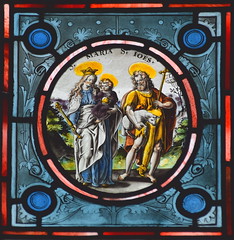 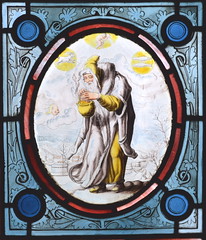 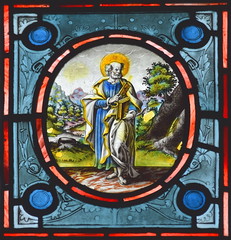
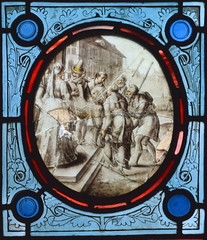 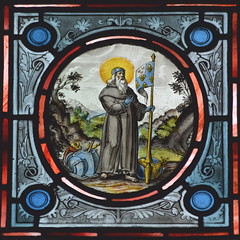 
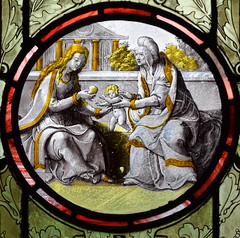 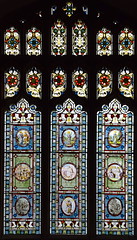 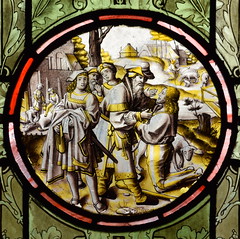
The font, though considerably
recut, is one of the best Suffolk examples of the 15th
century East Anglian style. There are feisty little wild
men around the base, and one of the shields features the
instruments of the passion. Another medieval survival
here, and a rare one, can be seen in the most easterly
windows of each of the clerestories. This is a pair of
stone corbel ledges that once supported the canopy of
honour over the rood. They are both carved elaborately,
and the northern one is castellated. The inscription on
the southern side reads Sancta Johnannes, Ora Pro
Nobis ('St John pray for us').
When the antiquarian David Elisha
Davy visited the church on Thursday 21st August 1834, he
was rather overwhelmed by what he found. This was, of
course, before Phipson's restoration and the installation
of the present stained glass windows. Rather, Davy got
bogged down with memorials to, and records of, the Long
family, and ran out of time, because the carriage he was
travelling by was only stopping in the town for two hours
on its way from Yoxford to Ufford, while the horse
was baited. I found so much that I was obliged to leave a
part undone, Davy complained, and Mrs Long's
death which took place the evening before will, probably,
add somewhat to the novelties which I shall find on my
next visit.
| Saxmundham was unusual for
a town in that it was almost entirely contained
in one manor, Hurts, the domain for centuries of
the Long family. One small part of the town was a
separate manor, Swans, and this gave its name to
the south aisle chapel of the church. In the
early 19th Century, Swans was in the ownership of
Dudley Long North, whose grand and slightly
alarming effigy can be seen in the North
mausoleum down the road at Little Glemham. At the time of the 1851 census of
religious worship, Saxmundham had a population of
just under 1200, some 200 of whom tipped up for
morning worship on the morning of the census.
This compared favourably with a similar number
turning up that morning at the independent
chapel, because in most East Anglian towns the
non-conformists greatly outnumbered the adherents
to the established church. Even so, Robert Mann,
the minister of St John the Baptist, was
sensitive about the size of his congregation and
felt the need to explain it. In common with many
of his colleagues across Suffolk, he made an
excuse for the poor attendance when he filled in
the census return. Uniquely in the county, he put
the blame on the absence of children, many of
whom are suffering from hooping cough.
Saxmundham church would, I am sure, need to make
no such excuses today. It feels a lively place,
at once mindful of its past and fitting for its
present.
|
|
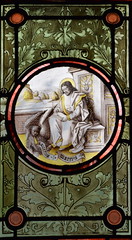 |
Simon
Knott, April 2018
|
|
|

